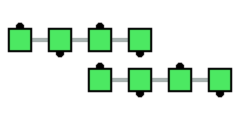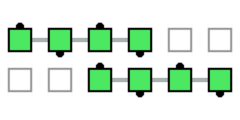

Consider what happens when two facing couples do a Pass Thru with each other. The individual dancers each need to move to a spot that is directly in front of them, but they can't physically pass through each other, so they modify their paths slightly, to pass right shoulders (i.e, by temporarily adjusting sideways a bit to their left).

As a result of that, if they pause the action halfway through they will be standing adjacent to each other. This kind of intermediate position can occur with many calls. For example, dancers are in a similar position halfway through a right pull-by. And note that from facing couples a Box Circulate is the same action as a Pass Thru, and so 1/2 Box Circulate (from this formation) is equivalent to stopping halfway through a Pass Thru.

Another way of looking at that kind of case is that each dancer is doing 1/2 Box Circulate and aiming to end on the spot exactly halfway between the starting and ending point for a full Box Circulate. But they can't actually end on the same spot, so they adjust to be as close as possible to that spot, holding right hands.
The same thing happens with a 1/2 Box Circulate from back-to-back couples. The two dancers in each couple are "aiming for" the same spot, halfway along the curved path they would each normally travel to do a full Box Circulate, but they can't actually both end on that spot, so they approximate the same spot as closely as possible by standing adjacent to each other holding right hands.

These kinds of 1/2 Circulate cases are very common. And as noted above, it is possible to explain them simply in terms of the right-shoulder passing rule. But there are also cases (though less common) where a full Box Circulate can leave two dancers attempting to occupy the same spot.
Consider, for example, a Split Circulate from parallel inverted lines with the centers facing in and the ends facing out. Following the normal rules of a box circulate, each trailing dancer (in the center of a line) wants to occupy the spot one position forward from his/her starting position, but each lead dancer (at the end of a line) simultaneously wants to occupy the spot one position to the side of his/her starting position -- and in this case those are the same spots.


Much the same thing can happen on an Hourglass Circulate, when the centers of the hourglass are in a facing diamond. The dancers moving from the centers of that diamond (the very centers of the hourglass) will each be trying to move (by veering outward) to one of the hourglass point spots, but another dancer will be trying to move (from the point position of the center diamond) to the same hourglass point spot.

This particular case is very important because there are many calls which end with some of the dancers doing what is, in effect, an Hourglass Circulate. There are of course the other hourglass calls (Cut the Hourglass, Flip the Hourglass) in which some dancers are doing an Hourglass Circulate. But there are also many other calls (without "hourglass" in their names) which end this way, with two dancers from the very center and two very outside dancers "moving up" to become ends of lines. And in any case where those dancers, just before doing that final "moving up", are arranged in a facing diamond, they will collide.
Calls that end with this kind of action include:

This formation is normally interpreted in terms of a "6x2 matrix", with the real dancers standing in eight of the twelve possible positions. At C-1, it is common for those twelve positions to be treated as three 2x2 boxes, using the Triple Box concept. So, more often than not, the next thing you hear after one of these kinds of collisions will be "Triple Box ...".

At C-2 and above, there is also a Parallelogram concept, which treats this formation as if it were two parallel waves. That is not used at C-1, but you will still hear the formation referred to using that term.
The caller can also just ask each line of four to do a regular four person call in the normal way (e.g., "each wave, Swing Thru").
To be prepared for whatever the caller is going to ask you to do next, and to help everybody in your square keep track of things, you should try to stand in a way that makes the offset situation very clear. Those in the center box should be careful to stand in a neat square shape with each other, and the outside four dancers should be careful not to stand in a way that might lead anybody to think they are part of the center box.
Watch these animations to see how dancers can end up heading for the same spot, and how they position themselves in such cases.
Many complex calls at Challenge have multiple parts that can take different forms depending on the starting formation. There may be a Trade -- which in certain cases is done as a Partner Trade. You may need to turn a "facing star" (danced like a circulate to the next position in the star).
With enough practice, you will come to see these kinds of things as normal, and to do them without hesitation. If you do them correctly -- and have enough confidence that you have done them correctly -- then all you will need to do when you find yourself coming to the same spot as another dancer is to take right hands, and adjust your position accordingly.
There are two ways that squares commonly break down in these kinds of situations: (1) somebody can fail to follow the rules of the call correctly, or (2) they can do everything correctly but they then panic when they see that somebody else is coming to the same spot. And then, because they assume this means they did something wrong, they turn around and run away, looking for some more comfortable place to go -- and they end up crashing their square even though they actually had done everything correctly up to that point!
Do not panic. Collisions at the ends of certain calls are fairly common. Yes, they sometimes happen because somebody did something wrong. But you should not assume that's why it is happening, unless you have some other evidence that somebody did something wrong.
Eventually, with enough experience, you will probably start to recognize which cases of certain calls are likely to end this way. But in the meantime, just make your best effort to do each step of the call correctly. And if you do that, and everybody else in the square is doing that, you can start assuming that when you find yourself coming to the same spot as somebody else it's probably supposed to be that way!